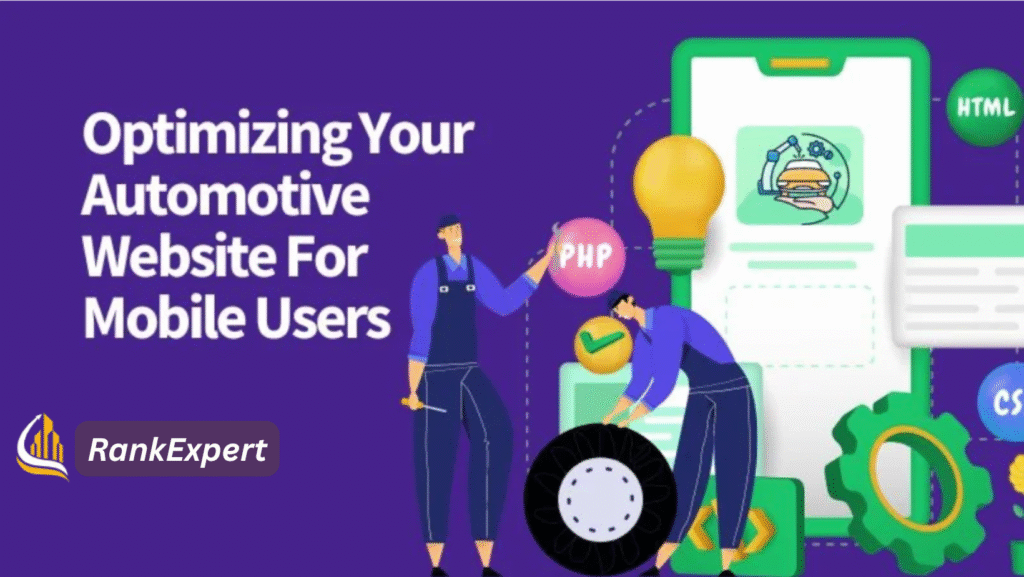Introduction
In today’s digital-first world, mobile optimization is no longer optional—it’s essential, especially for the automotive industry. With over 60% of car buyers starting their journey on mobile devices, optimizing your automotive website for mobile users can significantly improve user experience, boost SEO rankings, and drive more conversions.
Whether you’re a car dealership, auto parts retailer, or vehicle service provider, this guide will walk you through everything you need to create a high-performing mobile-friendly automotive website in 2025.
Also Read: SEO Tips for Tire Companies: Driving Organic Traffic to Your Website
Why Mobile Optimization Matters for Automotive Websites
Mobile users expect fast, responsive, and easy-to-navigate websites. If your website doesn’t deliver, users will bounce—often straight to your competitor. According to Google, mobile-friendliness is a ranking factor, especially for local searches like “car dealerships near me” or “auto repair services nearby.”
Key benefits of mobile optimization include:
- Improved mobile search rankings
- Enhanced user experience (UX)
- Increased lead generation and conversions
- Better Google Core Web Vitals scores
Essential Strategies to Optimize Your Automotive Website for Mobile Users
1. Responsive Web Design
A responsive design ensures your site adapts to all screen sizes—from smartphones to tablets. Google recommends responsive design over separate mobile URLs, as it maintains consistent content and improves crawl efficiency.
Tips:
- Use flexible grid layouts
- Optimize images with srcset for various resolutions
- Avoid Flash and non-mobile-friendly content
2. Improve Page Speed
Mobile users expect fast-loading pages. A delay of just one second can reduce conversions by 7%. Use tools like Google PageSpeed Insights and GTmetrix to audit performance.
Optimization checklist:
- Enable browser caching
- Minify CSS, JavaScript, and HTML
- Use lazy loading for images
- Implement a content delivery network (CDN)
3. Simplify Navigation and UX
For auto shoppers, simplicity is key. Ensure your menu is easy to access and clickable elements are touch-friendly.
Best practices:
- Use a sticky menu or hamburger menu
- Add a prominent “Call Now” button for mobile
- Highlight key actions: Schedule Test Drive, Get a Quote, Apply for Financing
4. Optimize for Local SEO
Most automotive searches have local intent. Optimize your site for “near me” searches by enhancing your Google Business Profile, adding location pages, and embedding maps.
Local SEO tips:
- Use location-based keywords: “auto repair in Miami”, “used cars Los Angeles”
- Add NAP (Name, Address, Phone) consistently across listings
- Collect mobile-friendly customer reviews
5. Mobile-Friendly Content
Content should be concise, scannable, and relevant to the buyer’s journey. Use structured data to help Google understand your pages.
Content tips:
- Use bullet points and subheadings
- Include high-quality mobile-optimized images of vehicles
- Add video walkarounds and mobile-first interactive features
Bonus: Use Mobile-First SEO Techniques
Google’s indexing is now mobile-first, meaning it primarily crawls the mobile version of your website. Your automotive SEO strategy must reflect this.
Mobile SEO checklist:
- Ensure mobile and desktop versions have the same content
- Use responsive meta tags and structured data
- Avoid intrusive interstitials or pop-ups
Tools to Help You Optimize
Here are some tools that can streamline your optimization process:
- Google Mobile-Friendly Test
- Google Search Console
- Ahrefs or SEMrush for mobile keyword analysis
- Screaming Frog SEO Spider
Final Thoughts
Optimizing your automotive website for mobile users isn’t just a trend—it’s a necessity. From responsive design and mobile SEO to local optimization and UX enhancements, taking a mobile-first approach will help you attract more visitors, generate qualified leads, and boost your search rankings in 2025 and beyond.
Also Read: How to Sell Backlinks Safely and Profitably in 2025

![Top Sportsurge.club Competitors & Alternatives: Complete Guide [2025]](https://rankexpert.net/wp-content/uploads/2025/07/1717659175-300x150.webp)

